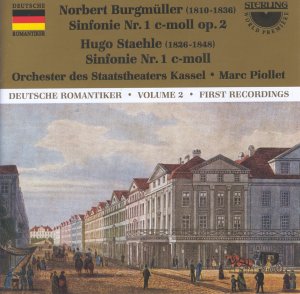Bo Hyttner's ability to surprise and please continues
unabated. He is a one man industry and his enviable ability to draw
in funding from a host of quarters is a phenomenon within the industry.
The present disc deserves to draw in many Dollars and Euros worldwide.
The result in the present case is a disc of two substantial
romantic era symphonies each in four movements. These were written by
German composers who died in their twenties in the first half of the
nineteenth century. This disc is the second in Sterling's 'Deutsche
Romantiker' series with the first having been a reissue of Wetz's much
later Third Symphony. This soon ended up competing with a similar CD
from CPO. Burgmüller may be known to some listeners and collectors
as a romantic era name. There might well have been a recording of his
piano concerto. However Staehle is utterly unknown to most of us. Cornelius
Grube's booklet note puts that right by providing a nicely detailed
picture of each composer's life and music.
Burgmüller wrote two symphonies, a piano concerto,
four string quartets and various lieder and piano pieces. He was tutored
by Spohr and played in the Kassel orchestra. Stricken by betrayal in
love he left Kassel and travelled to Berlin, Dresden and Magdeburg trying
to make a career for himself. The First Symphony dates from three years
after being forsaken by Sophia Roland. Beethoven (the lyric) and Schubert
(the dramatic) are to be heard here as well as uncanny similarities
with the Schumann of the First and Fourth Symphonies. The Symphony was
premiered in Schumann's Dusseldorf in 1834 and Mendelssohn conducted
the Symphony in Leipzig.
Staehle was one of Spohr's last pupils. He was taught
by Ferdinand David (another Spohr pupil) and Robert Hauptmann. He was
associated with Gade and with the Schumanns. Apart from a couple of
song cycles there is a piano quartet, a concert overture and the heroic
three acter Arria (1846) which was premiered in Kassel in 1847.
There are yet more Kassel connections as the Symphony was first performed
there on 18 December 1844 by the Court Orchestra. The music parallels
that of Mendelssohn in the Scotch and Italian symphonies.
The adagio cantabile is a very peaceable kingdom and the crown
of the work.
Piollet has the measure of these works and his orchestra
plays with real engagement - witness the scherzo of the Staehle in which
bubbling urgency meets a carefully graded approach to loud and quiet.
There are some deftly supernatural touches in that scherzo; eerie rather
like Weber in Freischütz. I have not previously heard the
clever musical effects mustered by Staehle in that scherzo. The orchestra
isn't an item of luxuriance or excessive abandon in the string department
but it is never less than good and the woodwind and brass are excellent.
After this I encourage Sterling to add two hyper-romantic
orchestral works from the 1920s to your catalogue. They are the Herbstsinfonie
and the Naturtrilogie by Joseph Marx. Also I wonder if I
must give up on ever hearing Atterburg's Ninth Symphony Visionaria,
on Sterling.
Rob Barnett


